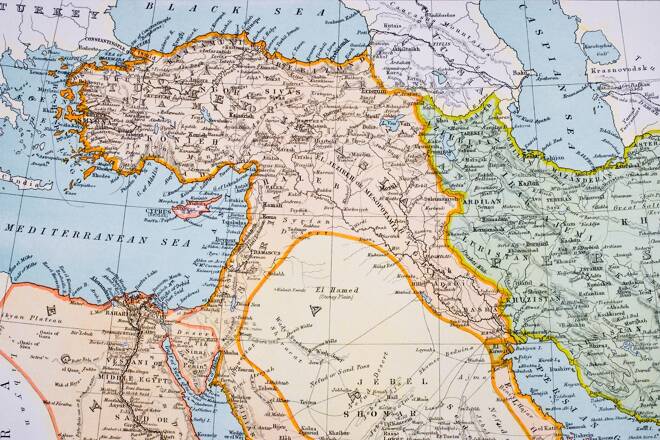Advertisement
Advertisement
Policy Reversal in Turkey, Consolidation in Egypt Crucial for Coping With Large External Deficits
By:
Policy reversal or consolidation? Turkey needs the former while Egypt needs the latter if the two middle-income countries are to avoid deeper balance-of-payments problems amid elevated global rates.
Economic output in Turkey is more than double that of Egypt with a similarly sized labour force but both have large external financing requirements as domestic savings fall short of investment needs, resulting in large, sustained current-account deficits. Both countries are also strategically important for Europe, notably in terms of their energy endowments.
Egypt and Turkey face tough policy trade-offs as the pandemic and energy crises have worsened long-standing macroeconomic imbalances, which are now in danger of further deterioration as external borrowing costs have risen and currencies fall against the dollar. Financing risks have intensified. Ten-year international bonds trade around 9% for Turkey and 18% for Egypt.
Turkey’s relative resilience is helped by its more diversified economy. However, the consequences of an unorthodox and counter-productive monetary policy – in which real rates remain one of the lowest in the world even as inflation stays high – represent significant risks given the uncertainty over the outcome of general elections due on 14 May.
Egypt is trying to address its economic imbalances more positively but that leaves much riding on the enactment of stringent IMF-backed reforms centred on full liberalisation of the exchange rate and reducing the State’s role in the economy. Swift progress is essential to restoring international capital market access but is proving hard to accomplish, hence the delay of the IMF’s first review of the programme.
Figure 1: External financing needs are large relative to gross international reserves
% of gross international reserves (LHS), % of GDP (RHS)
Turkey’s Current Policy Mix Leads to Aggravated External Imbalances
Both countries have significant external financing requirements, but Turkey’s current policy mix is riskier than Egypt’s in the longer term. Turkey’s external financing needs (Figure 1) are estimated at USD 230bn in 2023, equivalent to around 25% of GDP, against Egypt’s more modest USD 23bn or about 6% of GDP (including IMF repayments but excluding short-term deposits from Gulf Cooperation Council members). This difference reflects the size of current-account deficits and the structure of external debt. Turkey’s external debt is primarily issued by the private sector, equivalent to 52% of the aggregate external debt, compared with around 20% for Egypt.
In Turkey, years of unconventional monetary policies have left the government dependent on domestic banks for funding in domestic and in foreign currency as foreign investors have exited domestic capital markets. Yields on 10-year lira bonds have fallen to around 12-13% from the more than 25% a year ago as new central-bank regulations have pressed domestic banks to buy more government bonds. Foreign investors’ ownership of Turkish government domestic debt fell to just 0.7% of the outstanding in February 2023 from 19.4% in 2017.
Turkish banks have managed to secure foreign financing and roll over most external debt, even during the 2018 lira crisis. The roll-over ratio has been below 100% since mid-2021. Refinancing risks have grown as banks’ access to hard currency increasingly relies on the central bank due to currency swap agreements, increasing uncertainty in times of market volatility.
Unwinding this closer relationship between sovereign and banking-system creditworthiness will be hard as any gradual normalisation in monetary policy could see sizeable losses in bank portfolios.
Figure 2. Central bank foreign assets are low when considering foreign liabilities
USD billion
Egypt’s Staggered Approach of Policy Adjustments Puts Its IMF Programme at Risk
The Egyptian authorities are working to improve the policy mix in exchange for relatively modest IMF financial support compared with the recent past. Egypt needs more foreign investment to improve the economy’s growth potential and tackle external imbalances.
However, while the country’s policy framework looks more encouraging than Turkey’s, significant reform looks unlikely before Egypt’s own presidential election in 2024 because of vested interests and the risk of social tensions amid rising inflation and widespread poverty.
Egypt is moving only fitfully toward a more flexible exchange-rate regime as gross international reserves decline (USD 34.4bn in March compared with USD 45.4bn at end-2019, Figure 2) and inflation rises (32.7% YoY in March). As another devaluation of the Egyptian pound looms, calls are growing for a steeper rise in the central bank’s lending rate despite 1,000 basis points of hikes since March 2022.
Egypt’s recent Sukuk issue (USD 1.5bn; 11% coupon) helps foreign-currency liquidity at the margin, but limited progress on privatisations involving Gulf-based investors illustrates how difficult the path toward reducing state involvement in the economy is proving.
Still, the policy mix is among the key rating considerations underpinning a one-notch differential between Egypt’s foreign-currency credit rating from Scope Ratings (of B) with that of Turkey (B-), the latter where a policy reset depends on the outcome of next month’s presidential election.
Scope Ratings’ next scheduled review dates are on 4 August for Turkey and 15 September for Egypt.
For a look at all of today’s economic events, check out our economic calendar.
Thomas Gillet is an Associate Director in Sovereign and Public Sector ratings at Scope Ratings GmbH. Levon Kameryan, Associate Director at Scope Ratings, co-wrote this commentary.
About the Author
Thomas Gilletcontributor
Thomas Gillet is a Director in Scope’s Sovereign and Public Sector ratings group, responsible for ratings and research on a number of sovereign borrowers. Before joining Scope, Thomas worked for Global Sovereign Advisory, a financial advisory firm based in Paris dedicated to sovereign and quasi-sovereign entities.
Did you find this article useful?
Latest news and analysis
Advertisement
